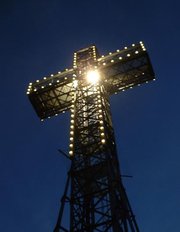Mount Royal
|
|
Alternate uses: Mount Royal (disambiguation)
Mount Royal (French: mont Royal) is a mountain on the Island of Montreal, immediately north of downtown Montréal, Québec, Canada, the city to which it gave its name.
The mountain is part of the Monteregian mountain chain situated between the Laurentians and the Appalachians. It gave its Latin name, Mons Regius, to the Monteregian chain.
Contrary to popular belief, Mount Royal is not an extinct volcano; however, it is the result of magma flows. It is a site where magma extruded into the Earth's crust and hardened into gabbro; subsequently, the surrounding earth was eroded, leaving the mountain behind.
The mountain consists of three peaks: Colline de la Croix (or Mont Royal proper) at 223 metres (732 feet), Colline d'Outremont (or Mont Murray) at 211 metres (692 feet), and Colline de Westmount at 201 metres (659 feet) elevation above mean sea level. At this height, it might be otherwise considered a very tall hill, but it has always been called a mountain.
Mtroyal.jpg
| Contents |
History
Mount-royal-cross-purple.jpg
The first European to scale the mountain was Jacques Cartier, guided there in 1535 by the people of the village of Hochelaga. He named it in honour his patron, King François I of France. He wrote in his journal:
- Et au parmy d'icelles champaignes, est scituée et assise ladicte ville de Hochelaga, près et joignant une montaigne... Nous nommasmes icelle montaigne le mont Royal.
- ("And among these fields is situated the said town of Hochelaga, near to and adjoining a mountain... We named this mountain, Mount Royal.")
The name of the city of Montreal derives from mont Réal, an orthographic variant introduced either in French, or by an Italian map maker ("Mount Royal" is monte Reale in Italian). The name had been unofficially applied to the city, formerly Ville-Marie, by the 18th century.
The first cross on the mountain was placed there in 1643 by Paul Chomedey de Maisonneuve, the founder of the city, in fulfillment of a vow he made to the Virgin Mary when praying to her to stop a disastrous flood. Today, the mountain is crowned by a 31.4-metre-high illuminated cross, installed in 1924 by the Société Saint-Jean-Baptiste and now owned by the city. It was converted to fibre-optic light in 1992. The new system can turn the lights red, blue, or purple, which last is used as a sign of mourning between the death of the Pope and the election of the next. (This operation was previously accomplished by changing all the light bulbs.)
Mount Royal Park
The mountain is the site of Mount Royal Park (parc du Mont-Royal), one of Montreal's largest greenspaces. The park, most of which is wooded, was designed by Frederick Law Olmsted, who also designed New York's Central Park, and inaugurated in 1876.
Lac-aux-castors.jpg
ski slope; a sculpture garden; Maison Smith, an interpretive centre; and a well-known monument to Sir George-Étienne Cartier. The park hosts athletic, tourist, and cultural activities, such as the tamtams held every Sunday in the summer.
The park is also home to the CBC's Mount Royal transmitter facility, which comprises two large buildings (one used primarily by the CBC and one used by the private television stations) and a very short (about 100 m) candelabra tower, from which nearly all of Montreal's television and FM radio stations emanate. Because of the close proximity of this tower to public areas of the park, in recent years significant concerns have been raised about radio-frequency radiation exposure; at several points formerly accessible to park users near the tower, radiation was found to be significantly higher than that permitted for the general public.
The lush forest was badly damaged by the 1998 ice storm, but has since largely recovered. The forest is a green jewel rising above downtown Montreal, and is known for its beautiful autumn foliage.
Outside the park, Mount Royal's slopes also bear such Montreal landmarks as Notre-Dame-des-Neiges Cemetery; Mount Royal Cemetery; St. Joseph's Oratory, Canada's largest church; McGill University and the Université de Montréal; and some well-off residential neighbourhoods such as Upper Westmount and Upper Outremont.
Mount Royal's Tam-Tams
TamTams1c.jpg
Over time, it has become the symbol of Montreal's diversity, since all type of people of various backgrounds, from college students to old hippies, spontaneously gather there. It is the place to be to relax and enjoy a leisurely moment under the sun.
TamTams3c.jpg
Nobody really knows when this spontaneous gathering began. It is not regulated by any authority, although policemen and first aid technicians are present to ensure the people's safety. The city also restricts commercial activity. Vendors may only sell items from approximately forty spaces around the central statue, they are not permitted to erect any kind of table or display, and vendors must register each week. While a few vendors work for nearby stores, many are simply local artists.
The Tam-tam spot of the Mount Royal is also a place favored by clubbers getting out of one of Montreal's four main after-hours clubs: Aria (http://www.arianightclub.com/), Stereo (http://www.stereo-nightclub.com/), Gravity (http://www.flashmediadesign.com/gravity/m_index.html) and Circus (http://www.circusafterhours.com/).
External link
Welcome to Mount Royal (http://www.lemontroyal.com/en_index.html)de:Mont-Royal fr:Mont-Royal pt:Monte Royal

